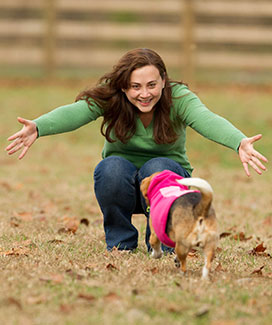Ph D student helping to improve the odds for endangered animal

Photo credit: Yehudi Hernandez
Jennifer Nagashima is passionate about saving endangered species. In her research at the Baker Institute, the Ph.D. student is focused on improving assisted reproduction techniques that can help endangered canids (dog-like mammals) like wolves and wild dogs reproduce in captivity. Nagashima is the first student to participate in the Cornell-Smithsonian Joint Graduate Training Program (JGTP), a shared graduate program in which she’s doing half her research here at the Baker Institute and half at the Smithsonian Conservation Biology Institute (SCBI) in Front Royal, Virginia. Through this unique program, Nagashima benefits from the help of two advisors: Alex Travis VMD, Ph.D., of the Baker Institute, and Nucharin Songsasen DVM, Ph.D., of SCBI.
An early interest in endangered animals
Nagashima discovered her interest in wildlife as a child. Watching an Animal Planet show on endangered tigers motivated her to do something to help endangered animals and she soon began volunteering at a zoo near her home in Palm Springs, California. She carried her interest in animals to Cornell, first as an undergraduate, and now as a graduate student.
Endangered canids struggling to reproduce
Of the 36 species of wild canids in the world, seven are listed as threatened or endangered and two are near extinction. To help rebuild populations of these animals, zoos have made efforts to get captive wolves, foxes, and wild dogs to breed. However, the old fashioned way of making canid pups can fail for any number of reasons, and distant institutions often want to breed their animals together without putting the animals through the stress of travel or upsetting their social packs.
To overcome these hurdles, zoos need to be able to use in vitro fertilization techniques like those used to help infertile human couples, but this is no small task. Female canids are only fertile once or twice per year, and once the female produces an egg it undergoes a days-long maturation process before it can be fertilized. Canid sperm also undergo a maturation process, so efforts to bring together canid eggs and sperm are notoriously difficult and no one has ever successfully produced a puppy from any canid species using in vitrofertilization.
Studying canine reproduction from both sides
Nagashima is tackling this challenge in domestic dogs, an effort that she hopes will eventually help bring some endangered canid species back from the brink of extinction. She’s getting help from Travis, who is guiding her work to optimize the preparation of sperm from male canids, and working with Songsasen on optimizing the preparation of eggs from female canids. Their results have been promising so far, says Nagashima, and she’s planning to publish them soon so that other labs and zoos can learn from the advances.
“By improving understanding of both the male and female sides of fertilization, we’ve improved our ability to produce dog embryos. In the future I hope to apply this new knowledge to assisted reproduction efforts for endangered canids,” says Nagashima.


